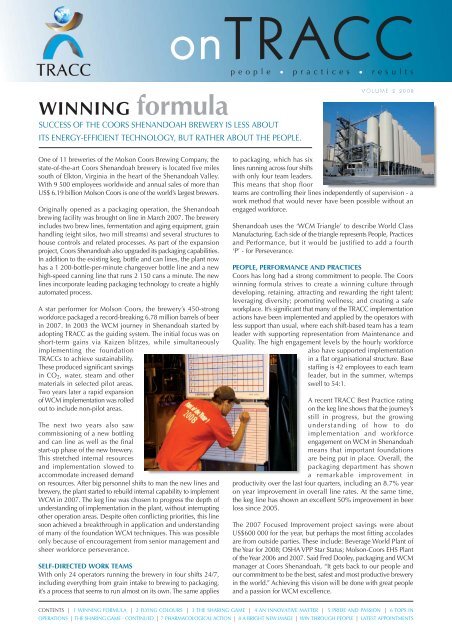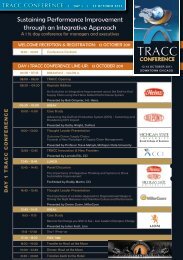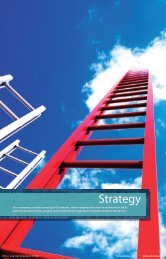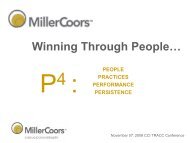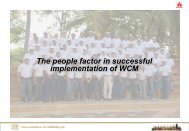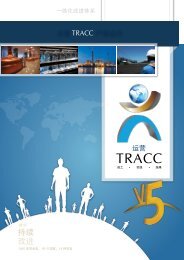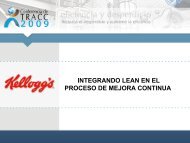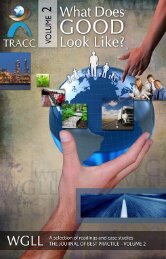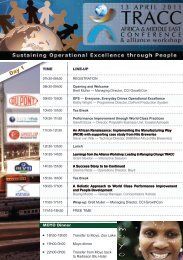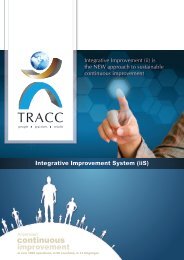WINNING formula - WGLL - TRACC
WINNING formula - WGLL - TRACC
WINNING formula - WGLL - TRACC
Create successful ePaper yourself
Turn your PDF publications into a flip-book with our unique Google optimized e-Paper software.
on<strong>TRACC</strong><br />
people • practices • results<br />
<strong>WINNING</strong> <strong>formula</strong><br />
SUCCESS OF THE COORS SHENANDOAH BREWERY IS LESS ABOUT<br />
ITS ENERGY-EFFICIENT TECHNOLOGY, BUT RATHER ABOUT THE PEOPLE.<br />
VOLUME 2 2008<br />
One of 11 breweries of the Molson Coors Brewing Company, the<br />
state-of-the-art Coors Shenandoah brewery is located five miles<br />
south of Elkton, Virginia in the heart of the Shenandoah Valley.<br />
With 9 500 employees worldwide and annual sales of more than<br />
US$ 6.19 billion Molson Coors is one of the world’s largest brewers.<br />
Originally opened as a packaging operation, the Shenandoah<br />
brewing facility was brought on line in March 2007. The brewery<br />
includes two brew lines, fermentation and aging equipment, grain<br />
handling (eight silos, two mill streams) and several structures to<br />
house controls and related processes. As part of the expansion<br />
project, Coors Shenandoah also upgraded its packaging capabilities.<br />
In addition to the existing keg, bottle and can lines, the plant now<br />
has a 1 200-bottle-per-minute changeover bottle line and a new<br />
high-speed canning line that runs 2 150 cans a minute. The new<br />
lines incorporate leading packaging technology to create a highly<br />
automated process.<br />
A star performer for Molson Coors, the brewery’s 450-strong<br />
workforce packaged a record-breaking 6.78 million barrels of beer<br />
in 2007. In 2003 the WCM journey in Shenandoah started by<br />
adopting <strong>TRACC</strong> as the guiding system. The initial focus was on<br />
short-term gains via Kaizen blitzes, while simultaneously<br />
implementing the foundation<br />
<strong>TRACC</strong>s to achieve sustainability.<br />
These produced significant savings<br />
in CO 2 , water, steam and other<br />
materials in selected pilot areas.<br />
Two years later a rapid expansion<br />
of WCM implementation was rolled<br />
out to include non-pilot areas.<br />
The next two years also saw<br />
commissioning of a new bottling<br />
and can line as well as the final<br />
start-up phase of the new brewery.<br />
This stretched internal resources<br />
and implementation slowed to<br />
accommodate increased demand<br />
on resources. After big personnel shifts to man the new lines and<br />
brewery, the plant started to rebuild internal capability to implement<br />
WCM in 2007. The keg line was chosen to progress the depth of<br />
understanding of implementation in the plant, without interrupting<br />
other operation areas. Despite often conflicting priorities, this line<br />
soon achieved a breakthrough in application and understanding<br />
of many of the foundation WCM techniques. This was possible<br />
only because of encouragement from senior management and<br />
sheer workforce perseverance.<br />
SELF-DIRECTED WORK TEAMS<br />
With only 24 operators running the brewery in four shifts 24/7,<br />
including everything from grain intake to brewing to packaging,<br />
it’s a process that seems to run almost on its own. The same applies<br />
to packaging, which has six<br />
lines running across four shifts<br />
with only four team leaders.<br />
This means that shop floor<br />
teams are controlling their lines independently of supervision - a<br />
work method that would never have been possible without an<br />
engaged workforce.<br />
Shenandoah uses the ‘WCM Triangle’ to describe World Class<br />
Manufacturing. Each side of the triangle represents People, Practices<br />
and Performance, but it would be justified to add a fourth<br />
‘P’ - for Perseverance.<br />
PEOPLE, PERFORMANCE AND PRACTICES<br />
Coors has long had a strong commitment to people. The Coors<br />
winning <strong>formula</strong> strives to create a winning culture through<br />
developing, retaining, attracting and rewarding the right talent;<br />
leveraging diversity; promoting wellness; and creating a safe<br />
workplace. It’s significant that many of the <strong>TRACC</strong> implementation<br />
actions have been implemented and applied by the operators with<br />
less support than usual, where each shift-based team has a team<br />
leader with supporting representation from Maintenance and<br />
Quality. The high engagement levels by the hourly workforce<br />
also have supported implementation<br />
in a flat organisational structure. Base<br />
staffing is 42 employees to each team<br />
leader, but in the summer, w/temps<br />
swell to 54:1.<br />
A recent <strong>TRACC</strong> Best Practice rating<br />
on the keg line shows that the journey’s<br />
still in progress, but the growing<br />
understanding of how to do<br />
implementation and workforce<br />
engagement on WCM in Shenandoah<br />
means that important foundations<br />
are being put in place. Overall, the<br />
packaging department has shown<br />
a remarkable improvement in<br />
productivity over the last four quarters, including an 8.7% year<br />
on year improvement in overall line rates. At the same time,<br />
the keg line has shown an excellent 50% improvement in beer<br />
loss since 2005.<br />
The 2007 Focused Improvement project savings were about<br />
US$600 000 for the year, but perhaps the most fitting accolades<br />
are from outside parties. These include: Beverage World Plant of<br />
the Year for 2008; OSHA VPP Star Status; Molson-Coors EHS Plant<br />
of the Year 2006 and 2007. Said Fred Dooley, packaging and WCM<br />
manager at Coors Shenandoah, “It gets back to our people and<br />
our commitment to be the best, safest and most productive brewery<br />
in the world.” Achieving this vision will be done with great people<br />
and a passion for WCM excellence.<br />
CONTENTS | 1 <strong>WINNING</strong> FORMULA | 2 FLYING COLOURS | 3 THE SHARING GAME | 4 AN INNOVATIVE MATTER | 5 PRIDE AND PASSION | 6 TOPS IN<br />
OPERATIONS | THE SHARING GAME - CONTINUED | 7 PHARMACOLOGICAL ACTION | 8 A BRIGHT NEW IMAGE | WIN THROUGH PEOPLE | LATEST APPOINTMENTS
FLYING Colours<br />
THE CHALLENGE FOR KENYA AIRWAYS HAS BEEN TO MAKE<br />
ITS PHENOMENAL GROWTH RELEVANT AND USE LESSONS<br />
LEARNT AS A SPRING BOARD FOR FUTURE GROWTH, WRITES<br />
CCI-GROWTHCON SENIOR CONSULTANT DERIK DUVENHAGE.<br />
National carrier Kenya<br />
Airways was founded<br />
in February 1977<br />
following the break-up<br />
of the East African<br />
Community and subsequent disbanding of the jointly owned<br />
East African Airways. Wholly owned by the Kenyan government,<br />
Kenya Airways was privatised in 1996 after which it acquired<br />
KLM as a strategic partner.<br />
Since then the airline has<br />
grown in leaps and<br />
bounds, serving more than<br />
2.7 million passengers<br />
annually and flying to<br />
43 destinations in 36<br />
countries. In addition to<br />
boasting one of the most<br />
modern fleets in Africa<br />
with 23 aircraft, Kenya<br />
Airways also is a major<br />
employer with more than<br />
4 000 employees.<br />
In the last three years, the airline has witnessed remarkable<br />
growth in its network and customer base. As such, it’s been<br />
challenged to meet rising expectations of staff, stakeholders,<br />
but most importantly an increasingly diverse customer base.<br />
Thus, the board and senior management decided to embark on<br />
a strategic plan to invest and develop people and systems,<br />
instituting various initiatives in most key departments.<br />
This thinking compelled Kenya Airways to seek ways and means<br />
to improve and enhance performance<br />
in the technical department. In 2006,<br />
CCI-GrowthCon was invited to submit<br />
a proposal to the technical department<br />
for an assessment of the mechanical<br />
and avionics workshops. In the<br />
assessment, opportunities were<br />
uncovered to reduce outsourcing of socalled<br />
BLR (beyond local repair) items<br />
and improve processes such as<br />
turnaround time and labour efficiencies.<br />
A limited best practice implementation<br />
over four months followed, with special<br />
focus on support services and processes.<br />
Lean principles such as identifying<br />
customer requirements, process<br />
mapping and waste identification also were applied.<br />
A year later, Kenya Airlines requested a similar assessment for<br />
Kenya Airways managing director Titus Naikuni (right)<br />
admires the plaque presented by CCI-GrowthCon’s Derik<br />
Duvenhage to mark the launch of World Class Operations<br />
in the technical department.<br />
Cargo Services, a division of the ground services department.<br />
The division is responsible for optimising the cargo belly capacity<br />
on passenger flights, as well as developing a dedicated freighter<br />
network. Using Jomo Kenyatta International Airport as its premier<br />
hub, KQ Cargo offers both belly and freight capacity mainly to<br />
freight forwarding agents.<br />
After completing the assessment, CCI-GrowthCon launched<br />
a pilot improvement<br />
programme in the unit load<br />
device section and the<br />
equipment maintenance<br />
workshops, with the<br />
emphasis on improved<br />
equipment availability. This<br />
soon resulted in positive<br />
client feedback and<br />
quantifiable cost savings.<br />
Based on CCI-GrowthCon’s<br />
proven methodology and<br />
encouraging results in the<br />
pilot areas, Kenya Airways<br />
signed up for a fully-fledged<br />
<strong>TRACC</strong> implementation in<br />
the technical and ground services departments towards the end<br />
of 2007. On 24 January 2008, World Class Operations (WCO)<br />
was launched officially by the airline’s managing director,<br />
Titus Naikuni.<br />
BENEFITS TO DATE<br />
At the beginning of the year, the project experienced some<br />
difficulty because of the post-election violence. Nevertheless,<br />
overall results have been good and there has been a strong<br />
endorsement from all quarters for<br />
WCO to continue. To date introductory<br />
training has been completed, steering<br />
committees and taskforces are in place<br />
and master trainers have been trained.<br />
In the Cargo Services division, a<br />
reduction of unplanned maintenance<br />
and sub-contractor costs has yielded a<br />
saving of KES14 million (USD215 000)<br />
over nine months. For the same period,<br />
the lower BLR costs in the technical<br />
division amounted to a saving of<br />
KES10.8 million (USD166 000). Other<br />
benefits realised such as reduced<br />
turnaround time and improved customer<br />
services haven’t been quantified. Combined, the savings translates<br />
to a 200% ROI for Kenya Airways – not bad for a WCO<br />
programme in its infancy.<br />
2<br />
www.etracc.net
The sharing Game<br />
CCI AUSTRALIA MD JOHN VAUGHAN-JONES IDENTIFIES<br />
CHARACTERISTICS NECESSARY FOR TRUE SHARING OF<br />
CORPORATE KNOW-HOW.<br />
Sophisticated software programmes have been the main enablers<br />
in structured approaches towards sharing corporate know-how.<br />
But a true understanding of what exemplifies successful sharing<br />
is still lacking.<br />
Shallow copying happens across companies and between plants<br />
within multi-site or multi-national organisations. Some of the<br />
incidents discussed below took<br />
place within global blue-chip<br />
organisations where copying<br />
was often simple, given the<br />
desire for replication and system standardisation in these<br />
environments. The risk of blind copying is given added impetus<br />
through knowledge management systems such as Microsoft’s<br />
Sharepoint ® (which also is used by CCI).<br />
REAL LIFE EXAMPLES<br />
By applying lean approaches diligently, as well as careful<br />
thought and involvement, a visual control<br />
technique had been developed for<br />
operators at a multi-national giant’s<br />
minerals processing installation in South<br />
America (Site A). This enabled operators<br />
and others in the area to visually identify<br />
the operating condition of critical<br />
equipment through standard work, plus<br />
a well designed Daily Management<br />
System. This beneficial technique has<br />
been expanded across the site.<br />
Site B is an identical operating unit of<br />
the same corporation located in another<br />
country. After seeing the technique at Site<br />
A, Site B managers introduced it at their<br />
plant. Tool/technique examples were<br />
replicated and implemented on identical<br />
equipment. However, within a short time,<br />
the flashy new tool had begun to rust<br />
through lack of use, and in one<br />
application, the colour-coded visual<br />
indicator itself had been lost.<br />
Where did it go wrong Transmission of<br />
and sharing specific templates and ideas<br />
usually isn’t the constraint. The real<br />
constraint is the failure to create an<br />
environment driving improvement from<br />
a lean perspective, which requires great focus. Once this is in<br />
place and thriving, the time is ripe for ideas or solutions seeded<br />
from outside the immediate environment.<br />
Some 15 years prior, the same thing happened across departments<br />
at a motor industry client. I had assisted in implementing a<br />
“Tools don’t make a lean environment.<br />
Lean is primarily a thinking process”<br />
Superb examples of Visual Control at Site A<br />
used diligently and to good effect, because the<br />
environment that created them also uses them.<br />
In such environments, transplanting ideas from the<br />
outside work well.<br />
visual daily management system on the engine assembly line.<br />
Results, typical of properly implemented lean approaches, were<br />
impressive (a 50% drop in defects per unit in 4 – 6 weeks).<br />
Managers from nearby processes noticed the results and<br />
requested assistance to implement this early stage of lean in<br />
their departments. Pressed for time, I asked them to wait a<br />
few months. The impatient managers then simply copied<br />
the engine assembly process.<br />
Unfortunately, what works in<br />
an assembly environment<br />
won’t necessarily ensure repeat<br />
success with a ‘copy and paste’ exercise in a machine-intensive<br />
continuous batch environment.<br />
One manager was responsible for the engine block machining<br />
line where the machine rather than the people adds product<br />
value (common in capital-intensive processes). So, if the machine<br />
runs smoothly and no machine-tool breaks occur, then no<br />
defects arise and takt is achieved.<br />
However, in an assembly environment,<br />
people need to follow detailed standard<br />
work practices diligently to achieve the<br />
desired result.<br />
After three weeks of trialling his new<br />
visual boards for daily management, the<br />
engine block machining manager asked,<br />
“Why is there no information on my<br />
board, while your engine assembly boards<br />
are filled with valuable information by<br />
mid-morning”<br />
Lesson 1: Copying a tool or technique<br />
without insight and understanding is<br />
highly likely to fail. Lesson 2: make sure<br />
that what you copy is appropriate to<br />
your process type (different lean tools<br />
are applied to different process types).<br />
Lesson 3: don’t blame the channel through<br />
which you copied when a tool or lean<br />
approach fails, blame yourself.<br />
REASONS FOR FAILURE<br />
Perfectly good systems, tools or<br />
techniques, each with a good fit in a<br />
particular lean environment, fail because<br />
of these common reasons:<br />
• They were copied by enthusiasts who<br />
had insufficient understanding about what it takes to grow a<br />
lean environment.<br />
• Tools don’t make a lean environment. Lean is primarily a<br />
thinking process. It’s critical to create a situation that searches<br />
Continued on Page 6<br />
www.etracc.net 3
Bill Hughes<br />
An INNOVATIVE matter<br />
by Arend Brink and Bill Hughes, CCI-GrowthCon<br />
BECAUSE OF MANY CHANGES TO THE PHILOSOPHY OF ASSET MANAGEMENT<br />
DURING THE LAST DECADE, A MORE INNOVATIVE APPROACH TO IMPLEMENTING<br />
AND SUSTAINING ASSET CARE BEST PRACTICES WAS BORN.<br />
Mining, an intrinsically dangerous<br />
industry, hasn’t been excluded<br />
from this journey. Management<br />
structures often were silo-based<br />
and conflicting. This resulted in<br />
high inefficiencies and maintenance<br />
costs per production unit<br />
as opposed to working as integrated<br />
teams with a common<br />
reference frame and shared goals.<br />
Arend Brink<br />
Initially, the Japanese realised this<br />
partnership’s importance and promoted it in the TPM concept.<br />
CCI-GrowthCon realigned this idea to accommodate a need<br />
to be more profit focused, realise the potential of supporting<br />
computerised systems and proactively expand the reliability<br />
maintenance approach. Alignment also<br />
encompassed eliminating on-thejob<br />
hazards caused largely by rapid<br />
expansion and the drop in technical skills<br />
and experience.<br />
The resultant strategy known as Business<br />
Centred Maintenance recognises that while<br />
quick results are essential to achieve<br />
programme buy-in and support, these<br />
results often aren’t sustained and personnel<br />
quickly revert to old habits.<br />
ASSET CARE STRATEGY<br />
To combat this, a comprehensive asset<br />
care strategy should be <strong>formula</strong>ted and<br />
signed off by the executive. A range of<br />
key performance indicators implemented<br />
at all organisational levels would ensure<br />
compliance.<br />
A people-system relationship is as fundamental to modern asset<br />
management as a production-maintenance relationship.<br />
Companies striving for high manufacturing efficiencies should<br />
view the asset management function holistically and not delegate<br />
responsibility to the most likely department (eg engineering).<br />
Consequently, the Business Centred Maintenance philosophy<br />
is based on a series of Key Success Factors.<br />
Companies maintaining an asset management function -<br />
particularly in the continuous process industry - need to<br />
consider learning points that have surfaced globally over the<br />
past 20 years: • An organisational structure supporting effective<br />
communication and clear responsibilities between the functions<br />
of Maintenance, Production, Materials Management and other<br />
departments • Sound technical skills at all engineering structure<br />
levels • An effective continuous improvement ethic linked to<br />
Maintenance crews working through the night at<br />
the Anglo Platinum Waterval Concentrator.<br />
financial results tracking • A strong Leading and Managing<br />
Change culture • A solid reliability-based maintenance<br />
foundation backed by support elements and underpinned by<br />
adherence to world class manufacturing basics: • A Talent<br />
Management support system • An internal assessment system<br />
addressing all the above to enable internal ownership of progress<br />
measurement and subsequent action plans supported by externalbased<br />
assessments<br />
LEARNING POINTS<br />
Often companies showing the following symptoms have difficulty<br />
optimising their assets and rarely, if they do obtain performance,<br />
manage to sustain it: • A traditional approach to maintenance<br />
(‘You run the machines, we fix them’) • Silo-based structures<br />
(Operations vs Maintenance) • No effective Root Cause Analysis<br />
(equipment failure is automatically the engineer’s fault) • No<br />
focused improvement initiative driving<br />
the asset management function to<br />
contribute to company profits (no<br />
measurable results from maintenance<br />
effort and maintenance seen as a cost,<br />
not a profit centre) • Poor teamwork and<br />
managers managing one level down (no<br />
or little ownership of assets at shop floor<br />
level) • The CMMS system is ‘windowdressing’<br />
(system fed with information –<br />
often inaccurate - to update management<br />
reports • Little or no maintenance forward<br />
planning - most work is executed<br />
reactively, leading to escalating costs,<br />
more breakdowns, compromising<br />
preventative maintenance and generally<br />
an unhappy working environment<br />
The absence of asset management basics<br />
often prevents a company from moving<br />
towards a sustained best practice culture.<br />
Most failures in the continuous process industry are because<br />
of competency-related issues as opposed to machine root<br />
causes. This inevitably means that equipment reliability isn’t<br />
always impacted by design characteristics, but rather external<br />
factors compromising machine availability.<br />
These external factors are aggravated by fewer technical skills<br />
and experience currently experienced by all industries. Retaining<br />
good technical skills is especially difficult in fast developing<br />
markets such as the mining industry. This situation demands<br />
greater focus to iron out potential hazards when developing<br />
modern reliability maintenance programmes.<br />
Asset management as a holistic business function will become<br />
critical for heavy industrial companies throughout the world to<br />
sustain high performance levels and execute a cost-effective<br />
asset management programme.<br />
4<br />
www.etracc.net
Pride and PASSION<br />
FROM MODEST BEGINNINGS AS A FAMILY-OWNED BUSINESS, THE NIGERIAN<br />
BOTTLING COMPANY (NBC) HAS GROWN INTO THE PREDOMINANT ALCOHOL-<br />
FREE BEVERAGE BOTTLER IN NIGERIA AND THE SECOND LARGEST IN AFRICA.<br />
CCI-GROWTHCON CONSULTANT TENDAISHE MASUKA TELLS ALL.<br />
NBC, one of the few remaining indigenous multi-nationals in<br />
Nigeria, manufactures and sells more than 1.8 billion bottles<br />
of 33 Coca-Cola brands annually. With increased global pressure<br />
on manufacturing industries to<br />
become more efficient and<br />
eliminate waste, NBC identified<br />
a need to engage the workforce<br />
in an improvement programme<br />
driven from the operational side<br />
of the business.<br />
The challenge was to implement<br />
TPM practices in a market that,<br />
though rich in mineral wealth,<br />
still exhibits mass poverty coupled<br />
with erratic electricity and water<br />
supply – factors that will stretch<br />
the morale of even the most<br />
optimistic workers.<br />
initiate structured problem solving and create a platform for<br />
recognition. TPM implementation followed in September 2007<br />
with strong emphasis on the Environment, Health and Safety,<br />
Focused Improvement and<br />
Business Centred Maintenance<br />
<strong>TRACC</strong>s, as these areas urgently<br />
required stability.<br />
To restore the equipment and<br />
develop some history on which<br />
to base the BCM strategy,<br />
Business Centred Maintenance<br />
basics also were implemented.<br />
Through training and focused<br />
support, the operational review<br />
meetings were strengthened to<br />
ensure each site had solid multidisciplinary<br />
teams driving daily<br />
performance.<br />
Supporting the need for improvement,<br />
senior management<br />
had earlier participated in a Six<br />
Sigma Green Belt programme<br />
delivered by Coke Atlanta. As a<br />
result, the value of understanding<br />
and supporting structured problem<br />
solving motivated NBC to<br />
integrate the TPM and Six Sigma<br />
methodologies.<br />
The approach was to pilot the<br />
concepts on two sites and then<br />
roll out to the remaining 11 plants<br />
using learnings from the<br />
initial implementation.<br />
Benin and Ikeja were<br />
the two pilot plants -<br />
each with unique<br />
climate and culture<br />
challenges, as well as<br />
relatively new equipment interspersed<br />
with older lines.<br />
CCI-GrowthCon launched the TPM<br />
programme in August 2007 on both<br />
sites with Yellow Belt and TPM star<br />
projects. These were aligned with the<br />
Coke Six Sigma approach and CCI-<br />
GrowthCon’s PIP philosophy<br />
respectively. Yellow Belt projects were<br />
aimed at middle management, the<br />
main goal being to deliver quick wins,<br />
“…..NBC seeks to meet its social and<br />
environmental responsibilities through the pursuit<br />
of two core principles: continuous improvement<br />
and sustainability.” – NBC website<br />
While it’s still early days, both<br />
plants already have seen<br />
significant performance<br />
improvements. Currently, Ikeja<br />
has five live Yellow Belt projects<br />
delivering savings of about<br />
USD188 000 a month, while<br />
Benin has six live Yellow Belt<br />
projects saving close to<br />
USD154 000 a month. Project<br />
improvements also were noted<br />
in changeovers and reduced<br />
bottle breakdowns on the<br />
Carbonated Soft Drinks (CSD)<br />
lines, as well as reduced<br />
carbon dioxide, water<br />
and caustic usage.<br />
Benin site saw the<br />
System Line Efficiency<br />
(SLE) of one pilot line<br />
(Line 3 – Juice line) leap from 47% in<br />
September to 61% in December.<br />
Across the two sites SLE figures<br />
have improved by more than 10%<br />
on average.<br />
For each plant the challenge is to<br />
sustain the gains, grow and create a<br />
climate that engages the workers by<br />
instilling pride and passion.<br />
www.etracc.net 5
TOPS in operations<br />
THE 2008 WINNER OF THE INTERNATIONAL MARTIN K STARR EXCELLENCE<br />
IN PRODUCTION AND OPERATIONS MANAGEMENT PRACTICE<br />
AWARD IS DR DINO PETRAROLO, GLOBAL HEAD OF MANUFACTURING<br />
DEVELOPMENT, SABMILLER PLC.<br />
Professor Martin Starr and<br />
Dino Petrarolo<br />
Instituted by the Production and<br />
Operations Management Society<br />
(POMS), the award recognises outstanding contributions to the<br />
POM field. It’s presented to an individual who has been<br />
exceptional in advancing POM practice, promoted the profession<br />
and linked industry and academia. Contributions may cover<br />
employment at several organisations during the candidate’s<br />
career. It is POMS’ most prestigious award in recognising a<br />
masterful practitioner and industry leader.<br />
A regular contributor and speaker at CCI’s <strong>TRACC</strong> user<br />
conferences, Petrarolo has<br />
had extensive operations<br />
management experience. He<br />
has always brought academic<br />
discipline and rigour to his practical work and has contributed<br />
to OM literature with noteworthy papers based on<br />
practical lessons.<br />
Petrarolo joined South African Breweries (SAB) in 1997 where<br />
his initial job was to move the company along its World Class<br />
Manufacturing journey. In 1999 he joined the team that planned,<br />
designed and implemented the latest SAB green-field brewery<br />
in Ibhayi, South Africa. This project constituted rigorous<br />
application of POM knowledge. Petrarolo focused on designing<br />
the management system for this innovative brewery. That system<br />
is now considered a global benchmark within SAB’s breweries<br />
“He has always brought academic<br />
discipline and rigour to his practical work”<br />
and bottling plants world-wide and has received considerable<br />
attention from companies in other industries.<br />
Petrarolo was promoted to group head manufacturing<br />
development in 2005, responsible for developing and<br />
implementing SABMiller’s global ‘Manufacturing Way’ initiative.<br />
In this position, he initiated a formal programme to codify the<br />
company’s best practices accumulated over 15 years around<br />
the world and instituted a common set of global key performance<br />
indicators (KPIs). These activities have received recognition<br />
both inside and outside SABMiller, including an invitation for<br />
presentations at the Cardiff<br />
Business School.<br />
Early in his career he worked<br />
for South African steel manufacturer Highveld Steel and<br />
Vanadium Corporation where he improved the inventory<br />
management system. He wrote a paper on managing spare<br />
parts inventory based on his experience. For this he received<br />
the Ingham Award for best journal article in 1990 from the<br />
South African Institute for Mechanical Engineering. Highveld<br />
Steel continues to use the Petrarolo system – 18 years later!<br />
Dino Petrarolo received his MS and PhD in Industrial Engineering<br />
in 1997 from the University of Witwatersrand in Johannesburg,<br />
South Africa.<br />
The sharing Game continued from Pg 3<br />
for and develops solutions, before attempting to short-cut this<br />
process by copying solutions. But, once this environment is<br />
established and developing, borrowing ideas from others must<br />
become a key part of the process.<br />
• Understanding your specific value-adding<br />
process is an important first step in the lean<br />
journey and insights from this will indicate<br />
the implementation process, as well as the<br />
most appropriate lean tools.<br />
• Beware of substituting systems or tools<br />
for thinking – you’ll fail.<br />
There’s a need to differentiate between<br />
‘structural and irreversible’ solutions to<br />
problems (such as moving a machine) and<br />
solutions involving behavioural change. It’s<br />
easy to imagine that ideas of the former type<br />
should be easy enough to copy and their<br />
benefits should be long-lasting by definition. This is indeed true.<br />
Not so for behavioural changes. These changes are reversible<br />
and need to be developed with the people involved. First by<br />
recognising the problem, then by accepting the challenge of<br />
The Site A technique copied to Site B. There’s<br />
nothing wrong with the idea itself, but the<br />
environment which should support it isn’t in<br />
place, hence its collapse.<br />
solving it, doing so and being committed to maintaining the<br />
solution and developing supporting systems to achieve this,<br />
such as leader standard work.<br />
A knowledge management system implemented prematurely<br />
in a lean journey might implode. And even<br />
if the KM system doesn’t implode, it may<br />
well be the catalyst for a failed lean journey.<br />
Decide on the priority and how to nurture<br />
the lean journey. A KM system implemented<br />
incorrectly or ill-conceived could be your<br />
undoing. But correctly implemented at the<br />
right journey stage, it could be one of your<br />
greatest assets.<br />
NOTE: CCI has enhanced the features of<br />
its flagship product Digi<strong>TRACC</strong> to include<br />
a much-improved knowledge sharing ability.<br />
Also, we’ve recently launched an integrated<br />
Sharepoint ® system operating alongside<br />
Digi<strong>TRACC</strong> to assist clients in sharing and learning. As with<br />
the examples discussed, these systems could be misused. Clients<br />
should use CCI-developed systems in an informed environment<br />
and not as substitutes for the thinking central to the lean journey.<br />
6<br />
www.etracc.net
PHARMACOLOGICAL action<br />
CCI BUSINESS PARTNERS TOMASZ SENDYKA AND<br />
MICHAL LOPACINSKI ´ OUTLINE POLISH DRUG MANUFACTURER<br />
POLPHARMA’S WCM IMPLEMENTATION.<br />
As one of the largest and most modern pharmaceutical plants<br />
in Europe, Polpharma specialises in manufacturing both generic<br />
and over-the-counter cardiological, gastrological and<br />
neurological drugs. Founded in 1935, Polpharma combines<br />
tradition and experience with modern technology and the<br />
highest manufacturing standards.<br />
After years of nationalisation, a milestone in the company’s<br />
history was its privatisation in 2000, funded solely through<br />
Polish capital. Privatisation gave the green light for thorough<br />
changes, which turned Polpharma into<br />
a strong business and the top player<br />
in the Polish pharmaceutical market.<br />
Together with the Medana Pharma<br />
Terpol Group, in which Polpharma<br />
is a majority shareholder, it’s the<br />
Polish market leader by volume<br />
of drug packages sold.<br />
Reinforcing its position in<br />
international markets, the<br />
company has representative<br />
offices in Russia, Lithuania,<br />
Kazakhstan, Belarus, Vietnam<br />
and the Ukraine.<br />
and rollout to other parts of the<br />
company in Stage 2 – the remaining<br />
sections of Dry Forms, as well as<br />
the Wet Forms and Infusions<br />
departments.<br />
Tomasz Sendyka<br />
Problem areas identified on these<br />
lines included a systemic lack of<br />
treated water for washing on the<br />
granulation side, as well as<br />
complex and extensive changeovers<br />
for packaging, often causing<br />
Michal Lopacinski ´<br />
prolonged stoppages. Three line<br />
operator teams were assigned to the granulation and<br />
packaging lines while profit improvement projects (PPZs) were<br />
introduced simultaneously.<br />
A structural analysis approach was followed with the emphasis<br />
on shortening washing time (changeover) of the granulation<br />
lines, as well as curbing changeover on the packaging lines.<br />
The immediate results were impressive - washing time dropped<br />
from 14.7 to 8.7 hours, while packaging posted a similar<br />
improvement after a SMED blitz with changeover time dropping<br />
from 11 to 6 hours.<br />
Competition in the generics<br />
market, particularly in Central<br />
and Eastern Europe, is robust.<br />
One of the main drivers for<br />
WCM implementation was<br />
the potential threat from<br />
competitors overtaking<br />
Polpharma’s generics market<br />
share - thus there was a need<br />
for improved flexibility. Since flexibility could be a growthlimiting<br />
factor, it could be addressed either via new capital<br />
investment or improving inherent process flexibility.<br />
Direct goals of the WCM implementation was to lower<br />
manufacturing cost and active ingredient losses, shorten<br />
changeover times and increase flexibility in response to market<br />
needs, without upping stock levels.<br />
Following a steering committee<br />
workshop in July 2005, part of the<br />
Dry Forms section was identified<br />
as the pilot area, as bottlenecks<br />
usually were encountered with the<br />
three granulation lines and, to a<br />
lesser extent, packaging. Stage 1 of the rollout embraced the<br />
<strong>TRACC</strong> Best Practices of Teamwork, VPM, Focused Improvement<br />
and 5S, supported by Set-up Time Reduction Blitz exercises in<br />
the pilot area. This was followed by broadening implementation<br />
“One of the main drivers for WCM<br />
implementation was the potential<br />
threat from competitors overtaking<br />
Polpharma’s generics market share”<br />
But results in the pilot area were most inspiring in terms of<br />
financial gains – direct cost savings amounted to €150 000 pa<br />
of which €110 000 was due to yield improvement alone. Future<br />
investment costs of €968 000 also were averted.<br />
To support production improvements, Polpharma requested<br />
additional support via a supply chain project. It was aimed at<br />
limiting stock levels and improving warehouse service flexibility,<br />
which resulted in better planning and delivery capability.<br />
Elements of <strong>TRACC</strong> foundation practices also have been<br />
rolled out to warehousing to improve communication and cooperation<br />
through Teamwork, order and organisation through<br />
5S and stimulate better support for production departments<br />
through VPM.<br />
It’s anticipated that once the company’s WCM implementation<br />
reaches maturity, it will up its<br />
production volume by 50-70<br />
million packages a year. The aim<br />
also is to increase the number of<br />
key brands from the current 10 to<br />
between 20 and 30.<br />
Recently, Polpharma became a<br />
member of the Gideon Richter Group, controlling local divisions.<br />
Since the results have been sustained and proved to be essential<br />
for company success, Polpharma has requested WCM support<br />
on its new sites.<br />
www.etracc.net 7
A BRIGHT new Look<br />
SINCE CREATING OUR CCI AND <strong>TRACC</strong> LOGOS MORE<br />
THAN A DECADE AGO, MUCH HAS CHANGED IN TERMS OF<br />
OUR OFFERING, MARKETS AND OF COURSE,<br />
MARKETING AND DESIGN TRENDS.<br />
Therefore, CCI took the bold step of updating its corporate<br />
image. We wanted to highlight our global penetration in 55<br />
countries, our emphasis on people, practices and results, as<br />
well as the value and<br />
dynamism that <strong>TRACC</strong><br />
offers our growing client<br />
base. The new logos, we<br />
hope, will be a just<br />
reflection of these issues.<br />
What does good look like<br />
This probably rates as the<br />
most frequently asked<br />
question CCI has had to<br />
answer during its 15 years<br />
in World Class Manufacturing. Though the <strong>TRACC</strong> toolkit<br />
certainly has placed and guided clients on the journey to WCM,<br />
users wanted to see more of what their peers were doing at<br />
various <strong>TRACC</strong> implementation stages. Guided by this appeal,<br />
CCI established a web-based visual knowledge bank in its quest<br />
to create a global <strong>TRACC</strong> community.<br />
The recently launched What Does Good Look Like (<strong>WGLL</strong>)<br />
website (www.etracc.net) forms part of a three-pronged offering<br />
to <strong>TRACC</strong> clients. Apart from full access to the site, community<br />
members will receive a PowerPoint presentation containing all<br />
contributing clients’ visual data submissions every six months,<br />
as well as a copy of the annual Journal of Best Practices.<br />
We invite you to visit the site, send feedback, make your<br />
submissions or join the online discussion group and become<br />
part of a growing WCM community.<br />
WIN through PEOPLE<br />
Join Competitive Capabilities International’s annual <strong>TRACC</strong><br />
conference at the Hilton Milwaukee, Wisconsin on 6 and 7<br />
November 2008 where the focus will be on Winning through<br />
People. The conference will concentrate on the critical people<br />
performance aspects of continuous improvement including<br />
organisational design, knowledge sharing, employee engagement<br />
and competency development.<br />
Leading international corporations such as Danone, Land<br />
O’ Lakes, SABMiller and Molson Coors will present case studies.<br />
A site visit to the SABMiller brewery in Milwaukee is included<br />
Pedro Torres has joined the GBU’s<br />
Latin American team as a consultant<br />
and will initially work with SABMiller<br />
in Panama. He’ll also be available for asset<br />
care assignments elsewhere in the GBU. Pedro<br />
has 28 years’ experience in EAM/CMMS<br />
implementations, Asset Management and<br />
QSH&E, of which 17 years was spent as a<br />
logistics engineer in the oil, gas and mining<br />
industry. As a naval officer, he focused on<br />
electronic maintenance engineering and<br />
navigation for 11 years. Pedro holds a degree<br />
in Mechanical Engineering and is currently<br />
studying for his Masters in Facilities<br />
Management at Cataluna University, Spain.<br />
Hugoh Ndudzo has joined CCI-<br />
GrowthCon in Johannesburg as a senior<br />
in the programme. On<br />
a lighter note, an<br />
evening event is planned<br />
at the new state-of-theart<br />
Harley Davidson<br />
museum. So, dust of<br />
those leathers and make<br />
sure to book your place!<br />
<strong>TRACC</strong> clients may attend the conference free of charge while<br />
a fee of US$495 applies to non-<strong>TRACC</strong> clients. To register visit<br />
www.ccint.net or e-mail chobbins@ccint.net.<br />
LATEST APPOINTMENTS<br />
consultant. Mainly focusing on BCM Asset Care, his main clients<br />
are Anglo Platinum and Coca-Cola SABCO. A qualified electrical<br />
engineer, Hugoh also holds an MSc in Manufacturing Systems<br />
and Operations Management, as well as a certificate in<br />
Marketing. He previously worked as engineering manager for<br />
SABMiller associate company Delta Beverages in Zimbabwe.<br />
Hilton Mentor has been appointed<br />
a consultant for CCI-GrowthCon, Western<br />
Cape. After graduating as a chemist from<br />
the University of Cape Town, Hilton started<br />
his career as a research technologist for<br />
global synthetic fibres company SANS<br />
Fibres. He subsequently moved closer to<br />
the coalface, ending up as continuous<br />
improvement manager.<br />
8<br />
CONTACT US AT: info@etracc.net • website: www.etracc.net<br />
Editing, production and design: Mariette Greyling, Tomar Communications


